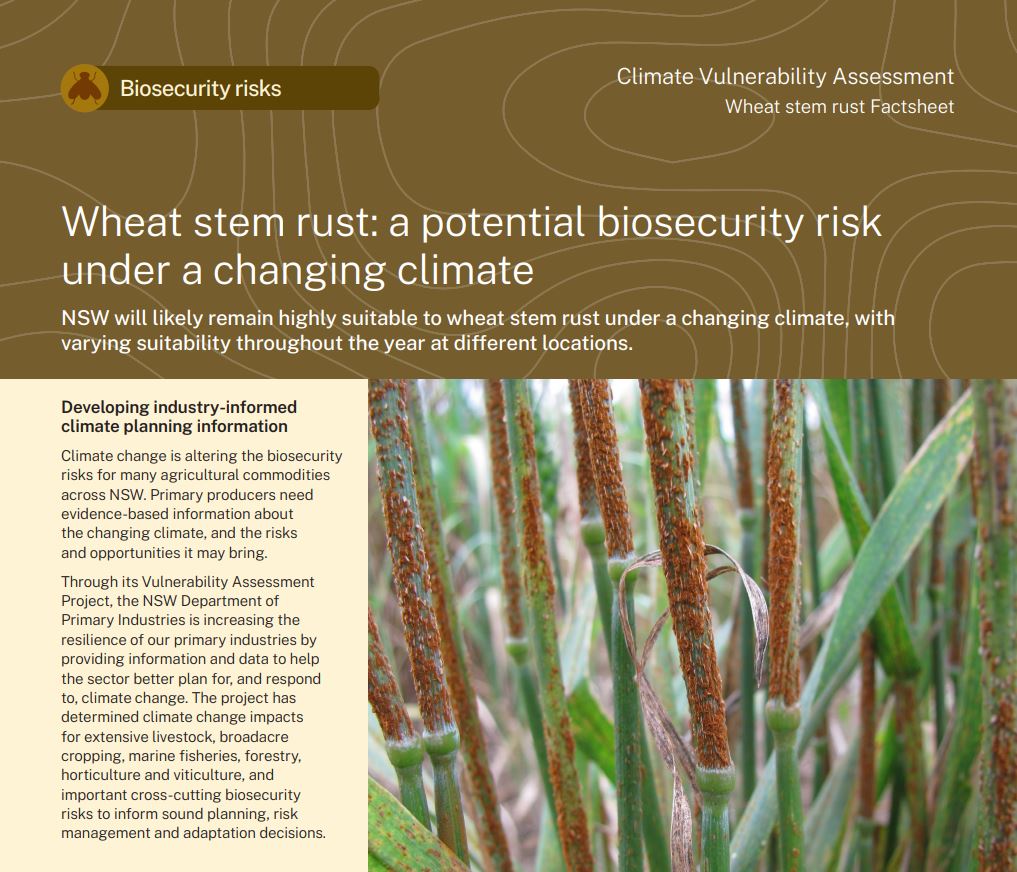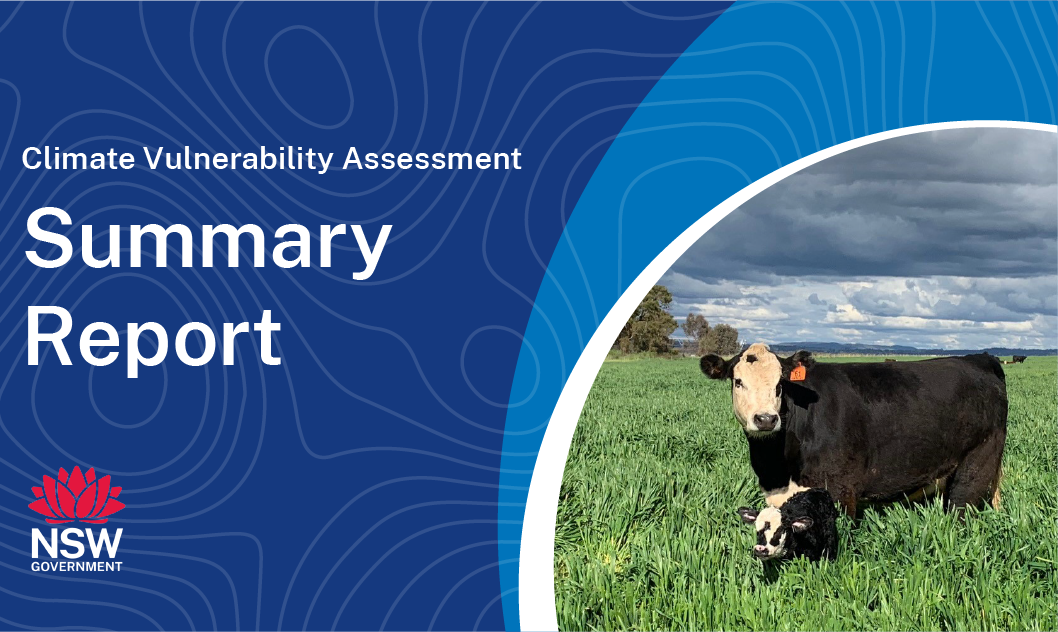What is the NSW DPI Climate Vulnerability Assessment? ⏷
Climate change is altering the biosecurity risks for many agricultural commodities across NSW. Primary producers need evidence-based information about the changing climate, and the risks and opportunities it may bring.
The NSW DPI Climate Vulnerability Assessments are enhancing the resilience of our primary industries by providing information and data to help the sector better plan for, and respond to, climate change. They have assessed climate change impacts for extensive livestock, broadacre and irrigated cropping, marine fisheries, forestry, horticulture and viticulture, and important biosecurity risks associated with these industries to inform sound planning, risk management and adaptation decisions.
How we assessed climate suitability ⏷
Climate projections were sourced from Climate Change in Australia’s ‘Application Ready Data’. This dataset is comprised of projections from an ensemble of 8 global climate models, each presenting a plausible future climate. Low confidence in the projected changes due to differences between the models is noted in the text. Care should be taken when interpreting these results.
The Climate Vulnerability Assessment is intended to highlight potential industry- or regional-level changes. Intermediate and high emissions scenarios were used in the assessments (RCP4.5 and RCP8.5), but these are not the only future scenarios possible. The inclusion of climate variables important to the commodities production was based on published research, expert knowledge and data quality and availability.
Climate suitability was assessed on a monthly timescale, with the reported climate suitability representing the average for a given month over all years in the dataset. This reflects the pattern of life stages for biosecurity risks and the need to determine which months are likely to pose the greatest risk to host commodities.
Learn more in the Climate Vulnerability Assessment Project Framework.
Climate impacts: expected challenges for primary industries
Changes in climate suitability are likely across all key life stages of wheat stem rust by 2050, under both emission scenarios.
Changes to overall monthly climate suitability for P. graminis are likely to affectwheat stem rust incidence in NSW in different ways:
- April to June and August to October – there are likely to be minimal to moderate increases in climate suitability in the wheat growing region . The increase is likely to be greatest under the high emissions scenario (moderate to high confidence).
- July – Climate suitability in the wheat growing region is expected to remain similar to what has been historically experienced under both emissions scenarios (moderate to high confidence).
- November to March – there are likely to be minimal to moderate decreases in climate suitability in the wheat growing region. The decrease is likely to be greatest under the high emissions scenario (low to high confidence).
The effects of wheat stem rust on the grain industry in NSW will depend on:
- the future distribution of grain-growing in NSW,
- changes in production timings, and
- the overlap between susceptible life stages of grains and the lifecycle of the wheat stem rust pathogen, P. graminis.
Under the future emissions scenarios, the climate suitability for southern NSW is likely to become more suitable for P. graminis, potentially leading to a higher likelihood of an outbreak of wheat stem rust should exotic or new virulent strains overcome the existing resistant wheat varieties. In contrast to this, in the north of NSW the wheat phenology is likely to shift out of the high-risk period of wheat stem rust infection around harvest, potentially decreasing the likelihood of outbreaks (see ‘Dryland and irrigated wheat’). Irrigated wheat production is more likely to be impacted by these changes.
The increase in climate suitability in September has the potential to increase infection risk earlier in spring under future emissions scenarios. The change of the key infection month from October to September may increase the risk of a significant wheat stem rust outbreak across the wheat growing region. Depending on how the same changes in climate suitability interact with wheat phenology (see page XX), and particularly the harvest window, wheat stem rust could once again become a problem in grain-producing regions in NSW.
There are rust-resistant wheat varieties and breeding programs underway to develop early-flowering wheat varieties which may to continue to shift the phenology out of the risk window of wheat stem rust. If wheat stem rust does emerge as a problem in NSW, grain growers may need to adapt by adopting earlier-maturing varieties, to minimise or avoid the wheat stem rust window, or by increasing late-season fungicide applications, which carries an enhanced risk of exceeding maximum residue limits in grains prior to harvest.
Due to changes in wheat stem rust timing, industries will need to consider broad reaching wheat stem rust education programs to raise awareness of the risks, management strategies and potential new strains.
Where can I find the climate suitability maps?
Maps of historical and future climate suitability for commodities were produced to demonstrate where in the state a commodity is likely to thrive or else be limited by future climatic conditions. The maps are not provided on these webpages but can be found in the Climate Vulnerability Assessment Summary Report (PDF, 41425.92 KB).
Wheat stem rust Factsheet
(PDF, 351.69 KB)

Summary Report
(PDF, 41425.92 KB)

 Wheat stem rust in NSW
Wheat stem rust in NSW